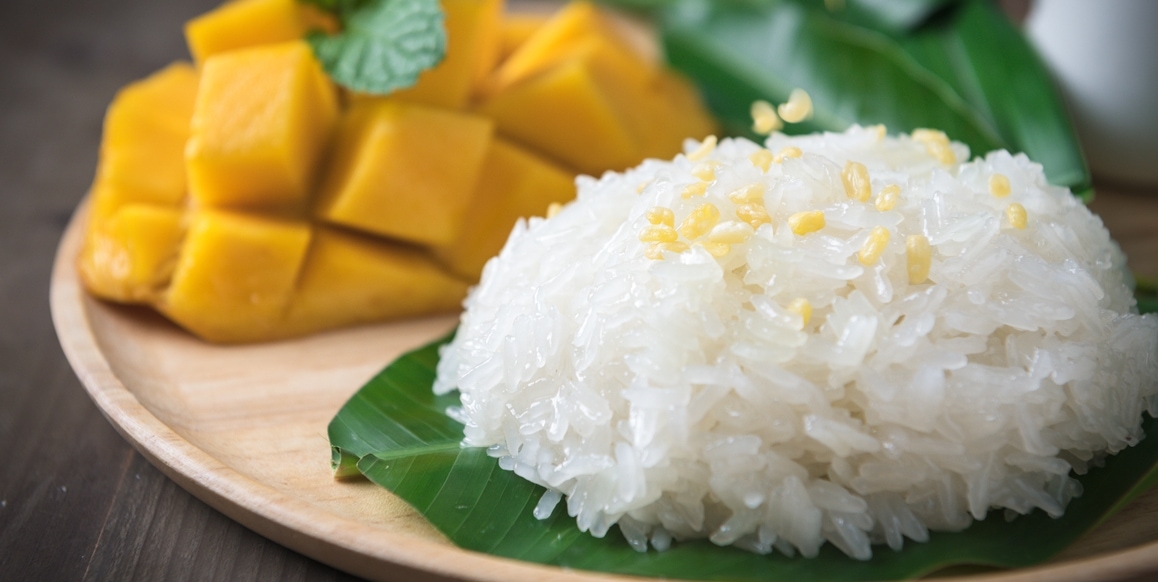Sticky rice is a type of rice that is sticky and glutinous. It's usually used in Asian cuisine. Sticky rice is known for its chewy texture and sweet flavor. It's perfect as a side dish to go with your favorite protein, and you can enjoy it any time of day.
What Is Sticky Rice?

Sticky rice is a type of rice that grows in Southeast Asia and parts of East Asia. It is a short-grain rice, meaning the grains are shorter and rounder than long-grain rice. The grains are also very sticky, hence the name. In traditional Southeast Asian cuisine, sticky rice is soaked overnight, steamed in the morning, and enjoyed all day.
Sticky rice is popular in many Asian countries, including China, Japan, Korea, Thailand, and Vietnam. It is often used in traditional dishes such as sushi, sticky rice cakes, and dumplings.
Sticky Rice Vs. White Rice
The difference between sticky and regular white rice is that sticky rice lacks amylose while regular white rice contains up to 30% amylose. This difference results in grains that separate in regular white rice while sticky rice remains sticky.
Another difference is that uncooked sticky rice is white and opaque, but uncooked regular white rice is somewhat translucent. Sticky rice also takes longer to digest than white rice, so it keeps you feeling fuller longer.
How to Cook the Perfect Sticky Rice
If you want to make the perfect sticky rice, the first thing you need to do is soak the rice in water for at least 4 hours (but no more than 24 hours). This will help soften the grains and make them easier to cook.
Drain the rice and place it in a steamer basket over several inches of boiling water. Make sure the rice doesn't touch the boiling water. Cover and steam the rice for around 30 minutes. Add more water as needed. Serve warm or at room temperature. Keep the rice covered so that it does not dry out.
When cooked properly, the grains should be soft and tender but still hold together well. If the grains are too hard or too mushy, it means that the rice was not cooked correctly.
Once your sticky rice is cooked, you can enjoy it as is or use it in any number of delicious recipes.
What Is Sticky Rice Used For?
Sticky rice is a versatile grain that can be used in a variety of dishes, both sweet and savory. You can enjoy it on its own or combine it with other flavors to create delicious dishes.
- Savory dishes
Sticky rice can be used as a base for stir-fries or as an accompaniment to grilled meats or vegetables. You can also serve it with a dipping sauce. Sticky rice is popular in dishes like sushi, sticky rice cakes, and Thai sticky rice.
- Sweet dishes
Sticky rice is often used in desserts and snacks because it has a sweet flavor and a chewy texture. It is sometimes served with coconut milk or other sweet sauces. You can make it into desserts, such as sticky rice pudding.
Buying and Storing Sticky Rice
Sticky rice is available at most grocery stores and Asian markets. You can find it in the international aisle or in the rice section.
When buying sticky rice, look for grains that are white, clean, and free of debris. Store your rice in a cool, dry place. If you store it in a warm or humid environment, the grains will start to clump together and will not be as sticky.
If you have leftover sticky rice, you can store it in an airtight container in the fridge for up to three days. You can also freeze the rice for up to one month. To freeze the rice, place it in a sealed bag or container and place it in the freezer. When you are ready to use it, thaw the rice in the refrigerator overnight.
Sticky Rice FAQs
Most rice contains two starches, amylose and amylopectin. Sticky rice does not have amylose but has a large amount of amylopectin. The amylopectin congeals and gives sticky rice its stickiness.
Sweet rice is another name for sticky rice.
Glutinous rice is another name for sticky rice. It is called glutinous rice because it is like glue and not because it has gluten. Glutinous rice, or sticky rice, is gluten free
Bottom Line
Sticky rice can be used in a variety of dishes. It can be boiled or steamed and is sometimes served with coconut milk or other sweet sauces. Sticky rice can also be used in savory dishes with meats or vegetables. Sticky rice is delicious on its own or combined with other flavors to create unique dishes.


